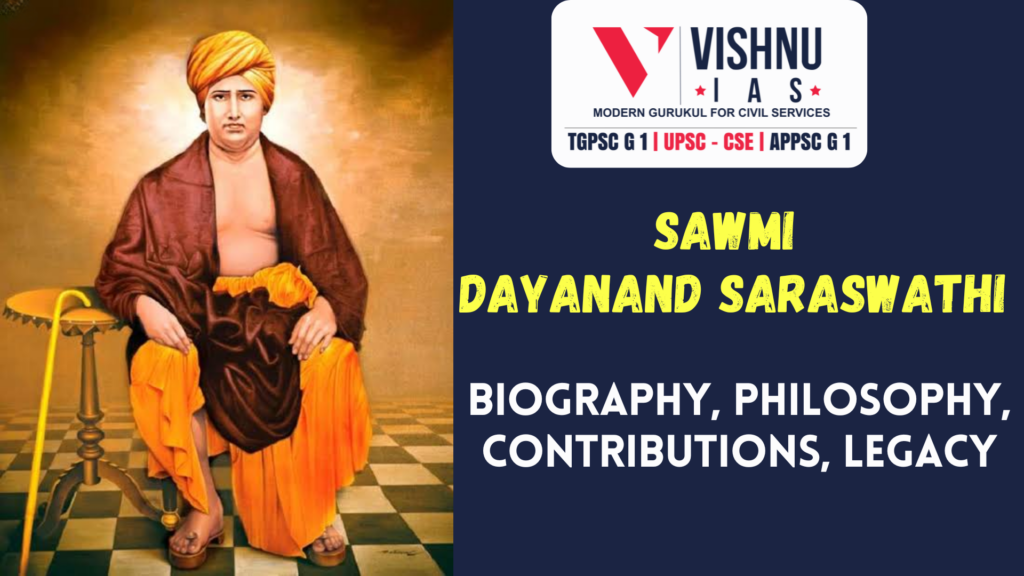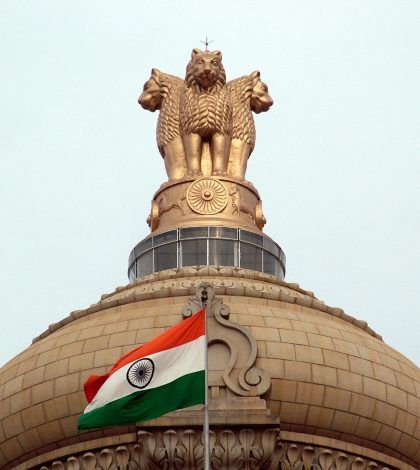Swami Dayanand Saraswathi
Biography, Philosophy, Contributions, Legacy
Dayanand Saraswati was born on February 12, 1824, in Tankara, Gujarat, as Mool Shankar to parents Karshanji Lalji Tiwari and Yashodabai.
His interest in spirituality was ignited by the death of his sister when he was just 14 years old.
At the age of 22, Mool Shankar departed from his home in pursuit of genuine knowledge, spiritual enlightenment, and moksha (liberation).
He spent fifteen years (1845-1860) wandering in search of a guru. In 1860, he encountered his blind guru and mentor, Swami Virjanand Saraswati, in Mathura.
Virjanand Saraswati bestowed upon him the name Dayanand and, as a form of gurudakshina, required him to pledge his life to the revitalization of Hinduism.
Veda was regarded by him as the foundational element of Hindu culture, deemed infallible and divinely inspired. He issued a powerful call to action with the phrase “Go Back to Vedas.” This slogan was intended to promote a revival of Vedic knowledge and the integrity of Vedic religion, rather than a regression to ancient practices. He was a vocal critic of the Hindu concept of maya, which he viewed as the dominant theme of all physical existence.
He extensively referenced the Vedas and other sacred texts to argue that the pursuit of salvation was not the sole objective for a Hindu or Arya, contrary to common belief. He emphasized the importance of leading a meaningful life dedicated to noble causes, asserting that salvation could be achieved through social service.
He opposed both Islam and Christianity, promoting the Suddhi movement aimed at reconverting individuals from other faiths back to Hinduism. He posited that God, the soul, and matter (prakriti) are distinct and eternal entities. His stance included opposition to idol worship, the caste system, ritualism, fatalism, infanticide, the sale of grooms, and child marriages. He championed the liberation of women and the upliftment of marginalized communities.
He suggested that the ideal age for marriage for women should be between 16 and 24, while for men it should be between 25 and 40. He was a pioneering figure in theology who embraced the advancements of science and technology. He adhered to the principles of karma and reincarnation and accepted the Vedic chaturvarna system, which categorizes individuals as Brahmin, Kshatriya, Vaishya, or Shudra based on their occupations.
Maharshi’s initial significant work was the “Panchmahayajya Vidhi,” published in 1874 AD.
He authored three notable texts: “Satyartha Prakash,” “Veda Bhashya Bhumika,” and “Veda Bhashya.” In 1875, he established the Arya Samaj in Mumbai with the aim of advancing social service initiatives.
Subsequently, the headquarters of the Samaj were relocated to Lahore.
In 1882, he founded the Paropkarini Sabha in Ajmer to facilitate the publication and dissemination of his writings and Vedic literature.
Notably, he is recognized for coining the term “swaraj” (self-rule) with the phrase “India for Indians” in 1876, a concept that was later embraced by prominent figures such as Lokmanya Tilak and Mahatma Gandhi.
Dayanand Saraswati passed away under questionable circumstances in 1883, following his outspoken criticism of the Maharaja of Jodhpur. Presently, his legacy is perpetuated through the Arya Samaj institutions located throughout India, along with the Dayanand Anglo-Vedic schools and colleges. The inaugural DAV School was founded in Lahore, with Mahatma Hansarj serving as the headmaster. Sarvapalli Radhakrishnan, who became India’s second President, referred to Dayanand Saraswati as “a maker of modern India.”


